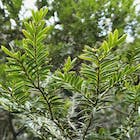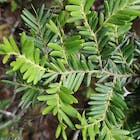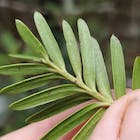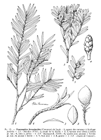
Foliage on a tree in habitat, in the humid forest of Mt. Mou [Adam Black, 2020.02.01, Facebook post].

Foliage on a tree in habitat, in the humid forest of Mt. Mou [Adam Black, 2020.02.01, Facebook post].

Detail of the underside of the foliage shown above [Adam Black, 2020.02.01, Facebook post].

Detail drawing from de Laubenfels (1972).

Pectinopitys ferruginoides
(R.H.Compton) C.N.Page 2019
Common names
None are recorded (Farjon 2010).
Taxonomic notes
Synonymy (Page 2019; see POWO for further detail):
- Podocarpus ferruginoides R.H. Compton 1922;
- Stachycarpus ferruginoides (R.H.Compton) Gaussen 1974 nom. nud.;
- Prumnopitys ferruginoides (R.H.Compton) de Laub. 1972;
- Stachypitys ferruginoides (R.H.Compton) A.V.F.Ch.Bobrov & Melikian 2000, nomen illeg.
The molecular analysis by Sinclair et al. (2002) considered a subset of taxa from throughout the Podocarpaceae that included 6 species in Prumnopitys sensu latu, representing the genera Pectinopitys, Prumnopitys and Sundacarpus. The 3 species of Pectinopitys, including P. ferruginoides, were in a group sister to a clade containing Prumnopitys and Sundacarpus; Little et al. (2013) obtained a very similar result in a later molecular study. This, along with many points of morphology, constitute Page's (2019) basis for assigning this species to Pectinopitys rather than Prumnopitys.
Description
Shrubs or trees to 20 m tall and 40 cm dbh; crown first conical, later open and cylindrical with short, ascending branches. Bark thin, yellow- to red-brown weathering dark gray, exfoliating in small scales. Leaves in two ranks or all around the twig, angled forward, straight, 9-15 mm (to 30 mm in juveniles) × 2-3.5 mm (Eckenwalder 2009).
Distribution and Ecology
New Caledonia, widespread but especially in the S half of Grande Terre, at elevations of 700-1400 m, scattered in dense humid rainforest in ultramafic areas, commonly with Retrophyllum comptonii (Thomas 2010). Based on data from 24 collection localities, it grows at elevations of 600 ±290 m. Within its range, mean annual temperature is 20°C, with an average minimum in the coldest month of 13°C, and a mean annual precipitation of 1920 mm (Biffin et al. 2011, Table S5). Zone 10 (cold hardiness limit between -1°C and +4.4°C) (Bannister and Neuner 2001). Phill Parsons of the Tasmanian Arboretum (email, 2023.07.06) reports that the species is doing well on a southeast-facing slope with average annual precipitation of 960 mm and mean temperature in the coldest month of 3.3°C.
This map shows herbarium records of Pectinopitys ferruginoides. Click on an icon for further information. Distribution data from GBIF (2020.03.30), edited to remove duplicates.
The IUCN classifies this species as "Least Concern" for human impacts due to its relatively extensive range and the near-absence of human threats such as habitat degradation or timber harvest.
Remarkable Specimens
No data as of 2023.02.21.
Ethnobotany
There are no recorded uses (Farjon 2010).
Observations
See the georeferenced collection records on GBIF (accessed 2023.02.27).
Remarks
The epithet references Pectinopitys ferruginea of New Zealand, recognizing its similarity.
Citations
Compton, R. H. 1922. J. Linn. Soc. Bot. 45:424.
Little, Damon P., Patrick Knopf, and Christian Schulz. 2013. DNA barcode identification of Podocarpaceae—The second largest conifer family. PLoS ONE 8(11):e81008. https://doi.org/10.1371/journal.pone.0081008.
Page, Christopher N. 2019. New and maintained genera in the taxonomic alliance of Prumnopitys s.l. (Podocarpaceae), and circumscription of a new genus: Pectinopitys. New Zealand Journal of Botany 57(3):137–53. https://doi.org/10.1080/0028825X.2019.1625933.
Sinclair, W. T., R. R. Mill, M. F. Gardner, P. Woltz, Tanguy Jaffré, J. Preston, M. L. Hollingsworth, A. Ponge, and M. Möller. 2002. Evolutionary relationships of the New Caledonian heterotrophic conifer, Parasitaxus usta (Podocarpaceae), inferred from chloroplast TrnL-F intron/spacer and nuclear RDNA ITS2 sequences. Plant Systematics and Evolution 233(1–2):79–104.
Thomas, P. 2010. Prumnopitys ferruginoides. The IUCN Red List of Threatened Species 2010: e.T42539A10719584. https://dx.doi.org/10.2305/IUCN.UK.2010-3.RLTS.T42539A10719584.en, accessed 2023.02.26.
See also
Association Endemia, a site devoted to New Caledonian species. Has excellent photos, a range map, and other information. In French.




